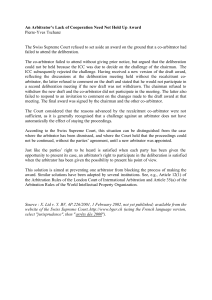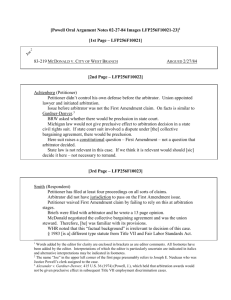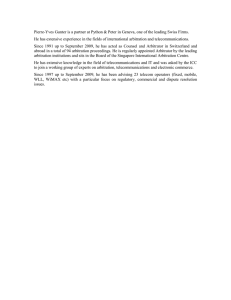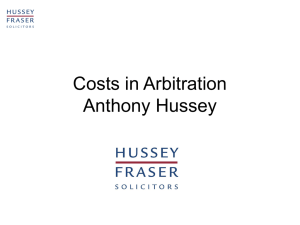CHAPTER 1 INTRODUCTION 1.1
advertisement
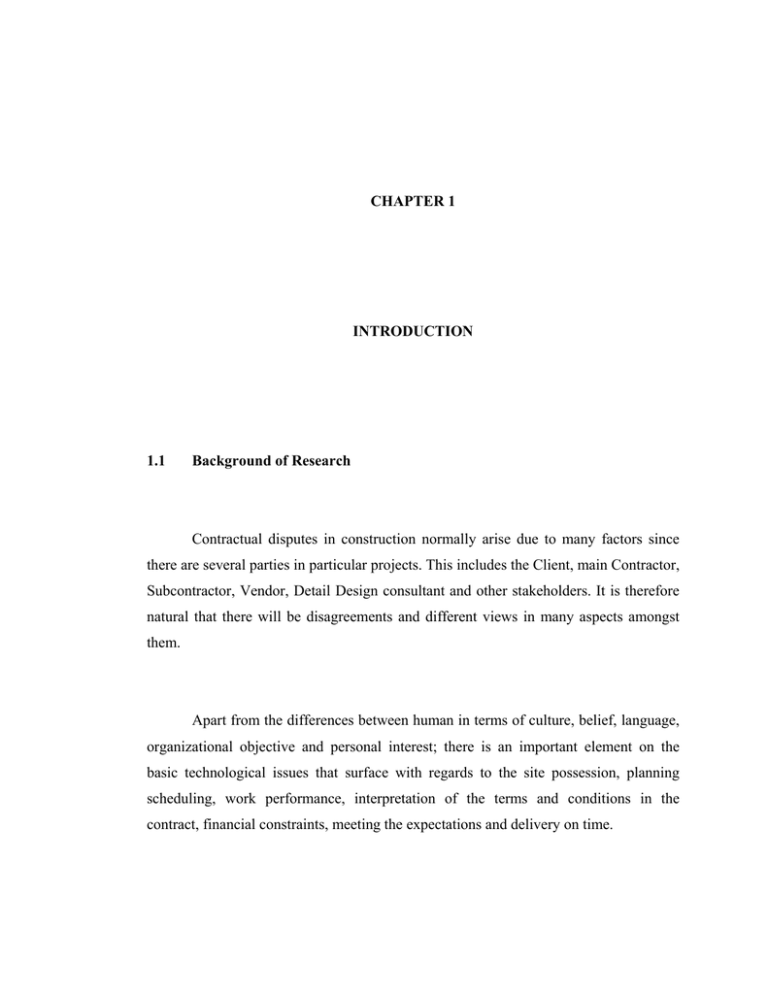
CHAPTER 1 INTRODUCTION 1.1 Background of Research Contractual disputes in construction normally arise due to many factors since there are several parties in particular projects. This includes the Client, main Contractor, Subcontractor, Vendor, Detail Design consultant and other stakeholders. It is therefore natural that there will be disagreements and different views in many aspects amongst them. Apart from the differences between human in terms of culture, belief, language, organizational objective and personal interest; there is an important element on the basic technological issues that surface with regards to the site possession, planning scheduling, work performance, interpretation of the terms and conditions in the contract, financial constraints, meeting the expectations and delivery on time. 2 In addition, there are also concerns and prolong discussion on the magnitude of the legal issues and its adherence of the contracting parties. Eventually, the other component that is significant in the construction field is to resolve the conflicts and disputes. Conflicts conflict occurs when objectives are incompatible. Dispute arise when a conflict becomes an altercation; perhaps when one or both of the parties becomes intransigent (from a behavioral point of view), but definitely when the argument revolves around rights and is justifiable¹. There are many ways to resolve the disputes, ie by adversarial or non adversarial in nature. The litigation, arbitration and adjudication are considered as adversarial in nature. Contrary stances have to be taken, and this frequently results in people becoming entrenched in their views. Often in adjudication, arbitration and litigation, the parties are represented by counsel whose skill and ability lies in the art of arguing and scoring points over each other1. The non adversarial method approach that has started to gain interest includes the mediation, conciliation, quasi – conciliation, private enquiry, mini trial and dispute resolution board. The Alternative Dispute Resolution (ADR, in short) may also comprise of a hybrid or combination of more than one of the various methods of dispute resolution such as mediation-arbitration, mediation-conciliation or conciliationarbitration2. As an arbitrator, a person must have a certain degree of qualification and attributes. Arbitrator must be knowledgeable, willing to devote professional time and resources with both parties regarding the representation. They also must be a neutral 1 2 Murdoch, J and Hughes, W ( 2008). “ Construction Contracts – Law and Management “. 4th Edition. Taylor & Francis. Neo, M ( 2005 ) . “ Construction Defects : Your Rights and Remedies “. Sweet & Maxwell Asia. pp, 9.1 3 third party, conforming to the legal and the governed Arbitration act. In Malaysia, the governing Act for the arbitration is Arbitration Act 2005 which now replacing the Arbitration Act 1952. An arbitrator should be exposed to the legal and justice that prevail in a country regardless whether they are with legal background such as former judges and lawyers or architects or engineers. As a conclusion, an arbitrator must render a professional legal service, having the undisputed technical background relevant to the subject matter; conform to the requirements of law and procedural conduct. 1.2 Problem Statement There are many criteria for a valid award. The court will not enforce and award unless3 it is : 3 1. Cogent 2. Complete 3. Certain 4. Final 5. Enforceable Mustill, M.J and Boyd, S. ( 1982 ).” The Law and Practice of Commercial Arbitration in England”. 2nd Edition. London, Butterworths. pp, 384. 4 Despite having the reputable and knowledgeable arbitrator, there are situation on which the final decision and awards made by the arbitrators are not agreed by the parties who engage them. This occur eventhough both parties have spend some amount of money to pay to the arbitrator to settle the dispute between them. Not only the arbitrator decision is disputed by the parties, there are also cases on which the parties go way further by applying to the court to remove the arbitrator from presiding the dispute on certain specified grounds. The factors relevant to the removal of arbitrator are generally as follows: - • Failure to proceed with due dispatch • Removal for misconduct The high court may remove the arbitrator for misconduct of himself or the proceedings. • Removal for lack of impartiality All arbitrators must be impartial. Impartiality has been described as the “ lack of impermissible bias in the mind of the arbitrator toward a party or toward the subject-matter in dispute”. It is “that quality of the arbitrator’s mind which enables him or her to decide the issues without a disposition to favour one side over the other; it is the antonym of bias”. • Where fraud is alleged in the pleadings • Resignation of arbitrator 5 From the above statement, questions such as, in what circumstances and what is the consideration to be taken by the parties before an award can be challenged? Why is the award been objected by the parties despite that it is ruled by a professional arbitrator? Is it true that those cases which are alleged by the unsatisfied party as being bad award and forwarded to court are agreed by the judges? Why does the court agree to set aside the award made by the arbitrator despite the award should be final and enforceable? What are types of faults of the arbitrator claimed by either party that judges held to be acceptable? Is the basis of rejection is due to the error on the face of the award or misconduct of an arbitrator? In this regard, the purpose of this research is to investigate on the common faults made by the arbitrators in the execution of their duties. 1.3 Research Objective From the problem statements stated above, the objective of the research is to investigate on the common faults made by the arbitrators in the execution of their duties. 6 1.4 Scope and Limitation of Research The scope of the study shall cover the following: - 1) Only cases which is related to the construction contract in Malaysia and outside Malaysia where needs arises. 2) The output, review and fundamental conclusion is derived based on the construction contract, case laws and governing law in Arbitration applicable for the cases selected. 1.5 Significance of Research The significance of this study is to clarify the items below : 1. To give a general understanding of the arbitrator obligation 2. To discuss on the varieties of faults made by the arbitrator resulting on their awards are been challenged by the unsatisfied parties 3. To have the clear perception of the role of an arbitrator and its limitation 7 1.6 Methodology In order to achieve the research objective, a systematic method in conducting this research had been organized. Thus, this research methodology shall explore on four major stages as per described below: 1) Initial study and background 2) Data collection 3) Data analysis 4) Conclusion and completion. 1.6.1 Initial Study Stage The first step of this research was to have initial study on the subject prior the final selection on the topic been made. The next step was to have a discussion with the supervisor/ lecturer on the topics coverage and material that might be needed to be of assistance. The Literature review and material relevant to these topics could also be obtained from the Malayan Law Journal, Building Law report, Construction Law report through the LexisNexis webpage. In any legal research involving cases, it is important to understand the hierarchy of the cases. If, for example, there are two decisions, one by the Court of Appeal and the other by a High Court, one should be first concerned by the 8 decision made by the Court of Appeal, which is binding on the High Court. Thus, the statement by the Court of Appeal is the “law “ 4 on the point. 1.6.2 Data Collection Stage As soon as the background and relevant issues were clearly defined, the material from literature review, legal cases and others would be collected. In principal, there were two types of data being collected, namely primary data and secondary data. 1.6.2.1 Primary Data Primary data was collected mainly from Malayan Law Journal, Singapore Law Report, Building Law Report, Construction Law Report and other law journals accessible through the Lexis-Nexis web server database. The main reason for giving primary attention to cases is that courts interprets statutes, constitutional provisions, administrative regulations, explain earlier court opinions on points of legal significance, and declare the meaning and scope of applications of legal rules5. 4 5 Anwarul Yaqin ( 2007 ) . “ Legal Research and Writing ”. International Islamic University of Malaysia. Malayan Law Journal Sdn Bhd. Anwarul Yaqin ( 2007 ) . “ Legal Research and Writing ”. International Islamic University of Malaysia. Malayan Law Journal Sdn Bhd, pp 97. 9 1.6.2.2 Secondary Data Secondary data was data obtained from research done by third parties other than the writer. Sources of secondary data consist of books, Acts, articles, research paper and seminar papers. These sources were significant in order to complete the content on literature review. Books published by the renowned authors were the main secondary data sources. These books which discussed in details on the concept of arbitration and their obligation in resolving dispute would be very helpful because it was explanatory and detail enough. Most of the books could be obtained from the UTM- Sultanah Zanariah Library , book stores and on line books. Journal, conference papers and articles were other sources to support the fundamental principle with regards to the topic covered. These papers were accessible through the online web server provided by the UTM - Sultanah Zanariah Library. 1.6.3 Data Analysis Stage After all the related material for this research had been accumulated, an analysis would be conducted to answer this research objective. The analysis would involve interpreting all the facts of the cases, judges statement, legal principles, statutory provisions and understanding. The data would be sorted, filtered and rearranged in order to align with the context of the research objectives and its limit of exploration. The write up would synchronise based on the material available and legal principles behind it. Eventually, a conclusion would be formed to give a proposed solution to the research statement and its pertaining issues. 10 1.6.4 Completion Stage Finally in the completion stage, an error checking was carried out to check on the correlation of data, validity of cases and literature review, and other additional factors for insertion with the guidance from a supervisor. All errors would need to be identified, amended and rectified. In summary, the most important fact was to ensure that the research mechanism had encompassed the issue and objectives that was established. 1.7 Chapter Organization This research dissertation will be divided into 5 chapters; and the outline of the Chapter is as follows : - 1.7.1 Chapter I – Introduction The first chapter is a general introduction on the topics, problem statement, objectives and scope, its importance, process and methods of approach and lastly the outline of chapters which formulate this research. 11 1.7.2 Chapter II – Arbitrator and Its Profession This chapter is a literature review of the background of arbitrator profession based on the resources from books, articles, journals, seminar papers and other journals. 1.7.3 Chapter III - Elements For Awards This chapter shall give the introduction on the criteria and disputes of the awards and standard duty of performance. 1.7.4 Chapter IV - Research Findings and Analysis This chapter shall demonstrate on the common faults by arbitrator made on the awards which subject it to being challenged by the disputable parties at court. 1.7.5 Chapter V – Conclusion & Recommendation The fourth chapter shall give a review on the analysis based on the relevant cases under construction contract matters. It will also highlight on the findings based on the statement and judges jurisdiction with regards to the common faults made by arbitrators in the execution of their duties. 12 1.8 Research Flow Chart Initial Study Literature Review Statement of Problem Research Objective Conceptual Framework Data Collection Documentation Review Case Review Analysis Writing - up Conclusion & Recommendation
